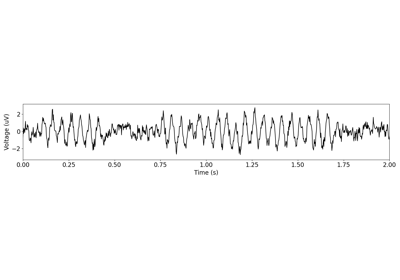neurodsp.timefrequency.compute_wavelet_transform¶
- neurodsp.timefrequency.compute_wavelet_transform(sig, fs, freqs, n_cycles=7, scaling=0.5, norm='amp')[source]¶
Compute the time-frequency representation of a signal using morlet wavelets.
- Parameters:
- sigarray
Time series.
- fsfloat
Sampling rate, in Hz.
- freqs1d array or list of float
If array, frequency values to estimate with morlet wavelets. If list, define the frequency range, as [freq_start, freq_stop, freq_step]. The freq_step is optional, and defaults to 1. Range is inclusive of freq_stop value.
- n_cyclesfloat or 1d array
Length of the filter, as the number of cycles for each frequency. If 1d array, this defines n_cycles for each frequency.
- scalingfloat
Scaling factor.
- norm{‘sss’, ‘amp’}, optional
Normalization method:
‘sss’ - divide by the square root of the sum of squares
‘amp’ - divide by the sum of amplitudes
- Returns:
- mwtarray
Time frequency representation of the input signal.
Notes
This computes the continuous wavelet transform at specified frequencies across time.
Examples
Compute a Morlet wavelet time-frequency representation of a signal:
>>> from neurodsp.sim import sim_combined >>> sig = sim_combined(n_seconds=10, fs=500, ... components={'sim_powerlaw': {}, 'sim_oscillation' : {'freq': 10}}) >>> mwt = compute_wavelet_transform(sig, fs=500, freqs=[1, 30])
